|
A Sculling Skiff for Young Wil |

|
|
By Jack Hicks - Logan, Utah - USA |
Late summer of 04 found Heather (my daughter) and I on the river, a weekly occasion, with the kiddies (Wil, then 5 and Ruby, then 4) and after awhile, as usual, the kiddies want to do the rowing.
 |
Wil rowing
(click images for larger views) |
|
Heather has a whitehall (a Jim Thayer hull) and I row a skiff of my own design. Wil is the quiet one of the two, but is a watcher of the first order. He doesn't care for instruction but bides his time until he's ready, then lets you know he wants to try. Well, you would have thought he was a seasoned rower; he has to walk the rolling seat back and forth, the oar overlap came naturally, and he could turn and back.
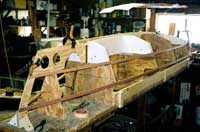 5 molds, stringers for the sheer and deck. chine to be tack/tape.
Thought I would try it but probably not again, aligning the panels was
too fussy and a chinelog (even a minimal one) is easier to eyeball. I
had some 1 1/2" styrofoam I used for some bulkheads, but the blue/pink
stuff is better for this. 5 molds, stringers for the sheer and deck. chine to be tack/tape.
Thought I would try it but probably not again, aligning the panels was
too fussy and a chinelog (even a minimal one) is easier to eyeball. I
had some 1 1/2" styrofoam I used for some bulkheads, but the blue/pink
stuff is better for this. |
|
Obviously, Wil was ready for his own boat.
I figured something on the order of a 10' wl. and a max. disp. of about 200# should be a starting point. I would shoot for a max. boat weight of 90#.
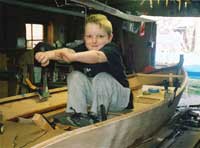 |
Trial fit for oarlock and footstretcher placement. |
|
I decided on about a 2/3 version of my skiff (16x4), but all ply to somewhat speed const. My skiff has ply for the bottom panels but stripbuilt topsides.
| Fitting skeg. The odd end is to carry the skeg to the end of the
waterline in an attempt to reduce the eddy that is apparent
in my skiff. |
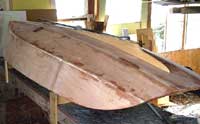
|
|
So, about 10' 6" loa, 10' waterline, 32" boa, 27" wl beam, 5 panel ply with double 1/4" keelflat, 1/4" bilge panels, and 5mm topsides. A full midlevel deck with a footwell and small side pockets for "stuff" would keep trapped water to a minimum (about 6 gal. as it worked out) and make the vessel unswampable.
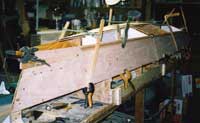 |
A lot of fussing to pull the hollow into the bow. A chinelog would
have helped but some wire and screws did the job. |
|
My skiff is nearly plumb bowed and wallsided in its forward sections and pushing into a steep windblown chop or dropping off a large wake can put water in the boat (or down your back), so I put some rake in the stem and a bit of hollow at the waterline.
| Internal framing |
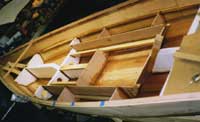
|
|
The sugarscoop stern has many elements in its favor. It makes recovery effortless, it's a swim platform, you can estimate your speed by the wake (in reality, an eddy), and beaching stern-to means never getting your feet wet. The only water I've taken up the stern has been due to inattention; when I'm fussing about with something and a wake catches me. The relatively wide stern (it's why I call them skiffs rather than pullingboats) provides good stability, and one can very comfortably stand and stretch.
|

The forward chine runs parallel to the waterline and slightly below. I used xynole polyester, a 4 oz. fabric that resembles cheesecloth, for sheathing. System 3 epoxy primer (and resins) is well worth the price.
|
|
I prefer easy manuverability as opposed to a straight tracker. A fair amount of rocker in the keel and a minimal skeg make for a boat that can turn on a quarter, if not a dime. I feel that one can learn to row straight, but you cannot "dance around" in a whitehall type, with its straight keel and the severe hollow at both ends.
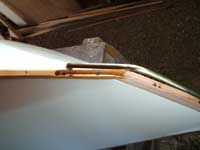 |
I read an article in MAIB by Robb White about using round stock instead of half oval for stems. Wonderful. |
|
I began lofting the hull on New Years day and we launched it the 3rd week in May, in primer and a minimal coat of varnish at our "season opener" on Starvation res. in northeastern Utah.
| Launching day, Starvation res. late May 05 |
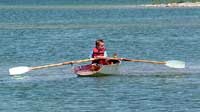
|
|
The finished boat, including oars and all parafinalia finished out at 74 pounds.
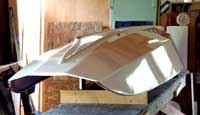 I use Sherwin-Williams marine/industrial enamel (sprayed) for finish. Dries very slowly , but is very durable. A piece of very old hard maple provided the keel strip. (in a previous life I acquired some maple flooring from a 100+ year old house and have been saving it for at least 40 odd years for stuff like this,--it's like iron.) I use Sherwin-Williams marine/industrial enamel (sprayed) for finish. Dries very slowly , but is very durable. A piece of very old hard maple provided the keel strip. (in a previous life I acquired some maple flooring from a 100+ year old house and have been saving it for at least 40 odd years for stuff like this,--it's like iron.) |
|
stable, which any "cruising" boat should be. |
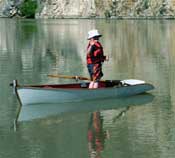
|
|
 |
Recovery drill |
|
Midsummer on the Bear river, Logan, Ut. |
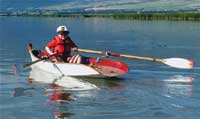
|
|
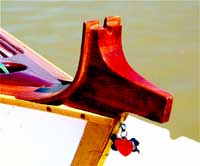 |
The stemhead is Northwest Indian derived. The rabies tag isn't. |
|
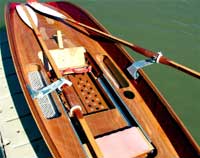 Stanley makes a gate hinge with hard plastic bushings with no "slop" whatsoever, that is the basis for the folding out riggers. I first used these on Heathers whitehall and have since converted my skiffs outriggers to them. They do not require any holdown in use. The oars are hollow square shafts (cedar) with glass blades--2 pounds apiece, 6'6". Stanley makes a gate hinge with hard plastic bushings with no "slop" whatsoever, that is the basis for the folding out riggers. I first used these on Heathers whitehall and have since converted my skiffs outriggers to them. They do not require any holdown in use. The oars are hollow square shafts (cedar) with glass blades--2 pounds apiece, 6'6". |
|
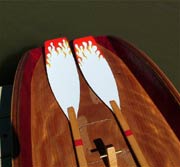 |
It's all about fun. |
|
|
Wil's favorite option is the lunchbox. Seat is on rollerblade wheels
riding on alum. angle stock. Bow hollow is apparent here. |
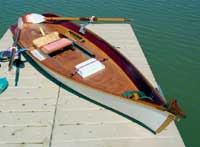
|
|
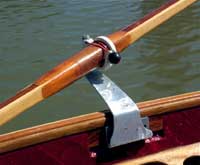 |
Oarlocks are made in a mold, thickened epoxy and glasstrands. Oar
sleeves are 2 wraps of glass and the collars are cuttings from pvc
fittings. |
|
|
Wind and rain on Flaming Gorge - northeastern Utah. |
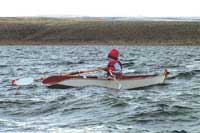
|
|
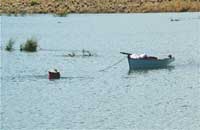 |
Sometimes Wil prefers to be in the water rather than on it. |
|
|
With buddies Elliot and Evan Hatch on Lake Powell, southern Utah. |
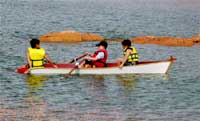
|
|
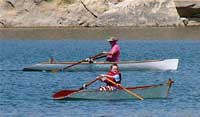 |
Wil and yours truly at Starvation. I've since lowered the oarlocks a bit. |
|
Comments: (sorry, closed due to spamming)
Christine 13 Feb 06 15:07
Jack has been a dear friend of mine for almost 30 years now. What talent! I am always in awe. A fastidious pricision of focus is his hallmark. Fine craftsmanship in any of a multitude of directions. And now the photography! I am honored to know and love you, Jack. I am so proud to display your art in my home.
Lee Skabelund 13 Feb 06 09:37
As Jack?s next door neighbor, I can verfy that he is a craftsman of the first order and matches that, as a neighbor! He is most patient and generous. Knowing his daughter and grandkids, he is also a super grandpa and mentor. Although not a rower, imagine my pleasure in watching progress on this and multiple other projects (Jack is multifaceted in skills and interests ? vehicles, metal, wood, glass and epoxy, music, sculpting and art in general). All forms of his work exhibit creative genius, attention to detail and exquisite quality. I go to him for great solutions. I wish you could see some of his other creations, especially his metal sculptures. I attribute much of his result to the classical music that emanates from his shop environment. Thanks for being here, Jack.
Read 02 Feb 06 19:56
Jack- A beautiful boat. Do you have plans for your adult sized boat?
Bill 24 Jan 06 19:55
Wonderful!What a lucky manchild.When I think back to the stolen boats I pried through the water as a youth ; can only predict that quick and dirty is not in his future.Congrat's
Carolyn J 15 Jan 06 14:46
This little craft is a beauty...other features! Wil rowed across an inlet (Flaming Gorge) in the blink of an eye--i was amazed. He gets in and out easily and the boat is small enough to nest inside Mom/Heather's when transporting.
Carin 13 Jan 06 17:19
Wow! Great job! Love the article, your workmanship is amazing!
Grace 13 Jan 06 17:15
I love you brother Jack......Grace
Barb Hansen 13 Jan 06 15:16
Hi Jack, How very exciting for you. Love reading the article, it was fabulous. The boats are ever so beautiful and the workmanship WOW! Barb
Jim Chamberlin 13 Jan 06 14:06
Ditto on all the aforementioned good things said. I, too would like to see details on the oarlocks. Great job!
Dave Hahn 13 Jan 06 13:55
Hi Jack,
Great article. Will's boat is a credit to you and I am sure that it is destined to become a multigenerational heirloom. Great pictures. I look forward eagerly to seeing your next article.
Steve Lansdowne 12 Jan 06 19:39
I imagine there is something very special about not just having one's own boat, but one JUST LIKE DAD'S!
Bob Throne 12 Jan 06 18:54
It's beautiful ! I'd like to know more about your lofting direct on to wood, no plans. Not even a drawing ? Just from your head to wood ?
Carl Di Stefano 12 Jan 06 16:10
Beautiful package. I'd like to make one for a 63 year old fat guy I know. You must publish this plan etc...
Kellan Hatch 12 Jan 06 12:51
You're an inspiration, Jack. This is about as good as it gets!
Jack Hicks 12 Jan 06 11:25
I very much appreciate the responses--
An article on making outriggers, oarlocks, oarblades and other epoxy/ composite parts is in the works, I will hurry it along. Alas, no plans exist. I loft the boats full size-a most pleasant undertaking that I'm sorry more builders don"t enjoy.
Derek Waters 12 Jan 06 11:04
Great stuff! I would like to second the requests for follow up articles and a plan set.
Al Straub 12 Jan 06 10:28
There is no greater reward than the smile that you put on young Wil's face. "You done good, Jack!"
Rob Rohde-Szudy 12 Jan 06 08:21
So, do you have plans for your skiff or the kid skiff? --Rob
Rob Rohde-Szudy 12 Jan 06 08:21
Those oarlocks are brilliant. (Note - they're not cast. They are gate hinges with the long tongue bent. I bolt through the end makes a thole pin.)
Jake Millar 12 Jan 06 04:42
Jack, I've admired your unique skiff in several MAIB photos - it's great to see a kid out on the water in such a cool boat. I'd like to see an article on how you make your outriggers, they look very simple and strong.
Pete Leenhouts 11 Jan 06 22:31
This article is a tribute to your ingenuity and skill, Jack, and a superlative example of the very best of Duckworks! Can we get a follow-on article on how to cast the oarlocks? |
|